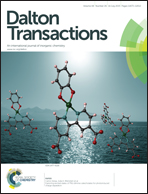Anion coordination selective [Mn3] and [Mn4] assemblies: synthesis, structural diversity, magnetic properties and catechol oxidase activity†‡
Abstract
Syntheses, crystal structures, magnetic properties and catechol oxidation behavior are presented for [Mn3] and [Mn4] aggregates, [MnIII2MnII(O2CMe)4(dmp)2(H2O)2]·2H2O (1·2H2O), [MnIII2MnII(O2CCH2Cl)4(dmp)2(H2O)2]·H2O·MeOH (2·H2O·MeOH), [MnIII4(μ3-O)(dmp)4(μ-DMSO)(N3)(DMSO)(H2O)]ClO4·DMSO (3·ClO4·DMSO), and [MnIII4(μ3-O)(dmp)4(μ-DMSO)(ClO4)(DMSO)(H2O)]ClO4·DMSO (4·ClO4·DMSO), developed with single type ligand H2dmp, 2-[(2-hydroxy-1,1-dimethyl-ethylimino)-methyl]-phenol. The successful isolation of 1–4 resulted from a systematic exploration of the effect of MnII salts, added carboxylates, Mn/H2dmp ratio, presence of azide, and other reaction conditions. The cores of 1 and 2 are similar and consist of a linear MnIIIMnIIMnIII unit in a carboxylate and H2dmp environment, revealing a central MnII ion in a different environment and terminal MnIII ions available for the introduction of structural and magnetic anisotropy to the system. The cores of 3 and 4 are also similar and consist of a distorted incomplete-adamantane type Mn4 coordination assembly in a carboxylate-free environment built on a triangular [MnIII3(μ3-O)] unit. The magnetic behavior of complexes 1–3 is dominated by antiferromagnetic exchange coupling that results in ground state spin values of S = 3/2 for 1 and 2 and S = 0 for 3. In solution, all four complexes 1–4 show catechol oxidation activity towards 3,5-DTBC. The catalytic activity for the oxidation of 3,5-DTBC in air followed the order 4 < 3 < 1 < 2.
![Graphical abstract: Anion coordination selective [Mn3] and [Mn4] assemblies: synthesis, structural diversity, magnetic properties and catechol oxidase activity](/en/Image/Get?imageInfo.ImageType=GA&imageInfo.ImageIdentifier.ManuscriptID=C5DT01157D&imageInfo.ImageIdentifier.Year=2015)

 Please wait while we load your content...
Please wait while we load your content...